Happy 73rd Birthday, Knesset!
As the Knesset, Israel’s legislature, marks its 73rd birthday, IDI is taking the opportunity to reflect on two of its characteristics; the social composition of its membership and its size as compared with other countries.
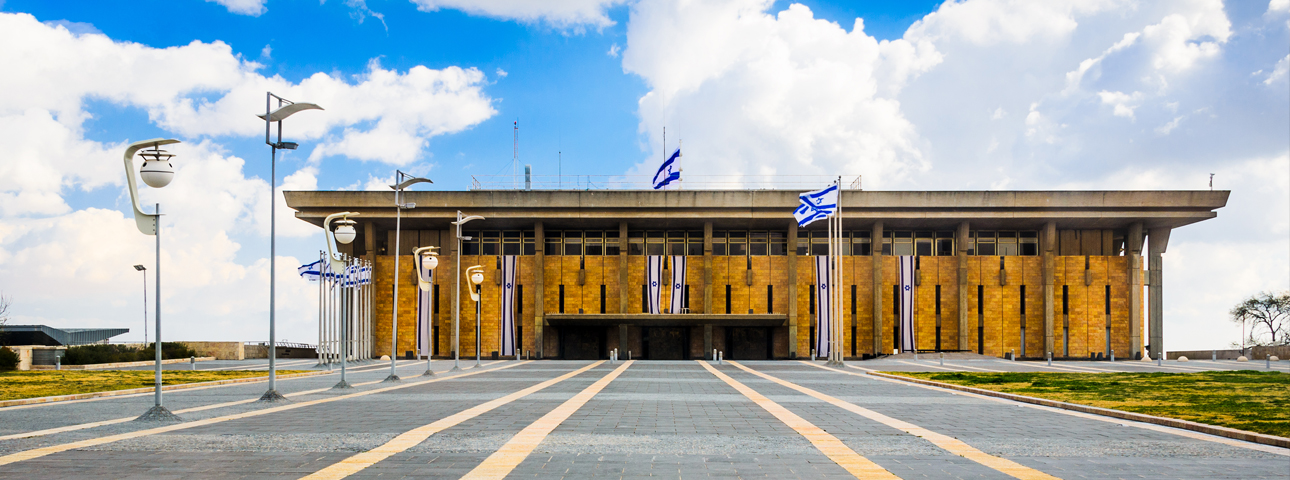
Knesset | Flash 90
The Knesset’s Members: A Mirror of Israeli Society?
At times, the Knesset, Israel's parliament, is referred to as “the legislature,” a term that testifies to one of its principal roles. It is also referred to as “the house of representatives,” since according to a widely-held perspective, it should reflect the diverse mosaic of Israeli society.
Nevertheless, many studies have shown that the parliament’s composition is not an accurate reflection of society. For example, even though women comprise approximately half the population, they make up a much smaller percentage of the members of the parliament. This is also true of other social groups, such as national and religious minorities, young people, and representatives of groups with lower socioeconomic status.
In recent years, many parliaments have begun closing gaps, diversifying their composition. The representation of women has been increasing at a constant rate over the past 20 years, as has the presence of social minority groups.
The Knesset has also become more varied over time. Part of the reason for this is demographics. In recent years, the composition of Israeli society has changed, including increases in the non-Jewish and ultra-Orthodox sectors. Another explanation has to do with changes in society’s values, for example, the significant increase in the number of women Knesset members is partially due to an improvement in the status of women in society.
The number of women Knesset members has soared from a nadir of seven after the 1988 elections, to a current record high of 36 (or exactly 30% of the total MKs). Of course, this number still does not reflect the proportion of women in the population, but is without a doubt, a significant improvement compared to the past.
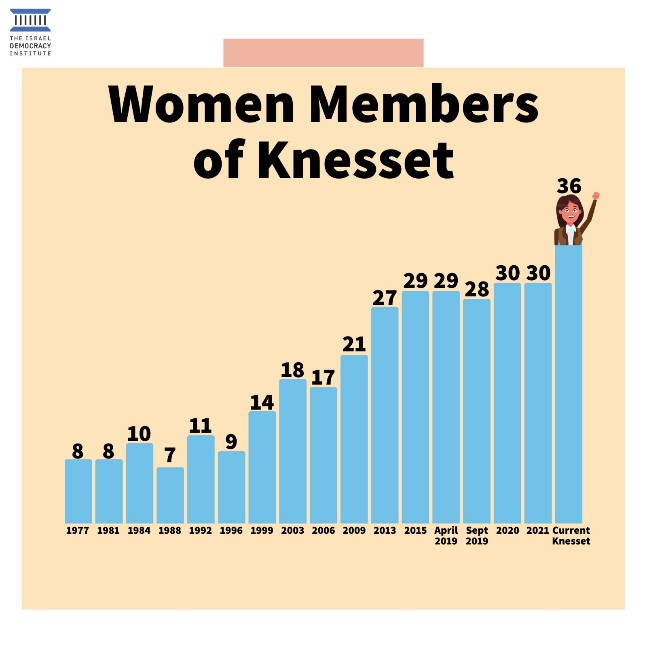
The changes in the composition of society also are expressed in the number of sabras, or native-born, Knesset members. Since from the time it was founded, Israel is an immigrant state and a large majority of members of the first Knessets were born abroad. Only fifteen members of the first Knesset were born in Israel. Native-born Knesset members were a minority until the tenth Knesset (1981). The first time that a majority of Knesset members were sabras, was in the Eleventh Knesset, which was elected in 1984.
The large wave of immigration from the Former Soviet Union during the 1990s slightly slowed down the increase in the number of native-born Knesset members, as quite a few new immigrants were elected, but the number of sabras has grown steadily over the past decade. In the last four elections, it stabilized around a level of 100 MKs.
A significant increase in the representation of other population groups in Israel’s legislature can be seen in the non-Jewish sector (Arabs and Druze). The number of non-Jewish Knesset members was fairly small until the 1990s; it has been increasing since then, and reached a high of 17 following the 2020 elections.
Non-Jewish MKs Over Time
The explanation for this increase stems mainly from the Arab population’s transition toward voting for Arab parties, such as Ra’am, Ta’al and Balad. Despite the increase in the number of non-Jewish Knesset members, their number is still not representative of their proportion in Israeli society, which stands at approximately 20 percent.
The changes that have taken place in Israeli society are also evident in the types of communities in which Knesset members reside. In the past, the number of kibbutz members in the Knesset was much larger than their share in the population. There were 22 kibbutz members in the first Knesset, far beyond their percentage in the population. The Knesset that was elected in 1984 included nine kibbutz members. However, the number of kibbutz members has gone down significantly since then, and only four kibbutz members are represented at present.
The number of Knesset members who come from development towns has also decreased steadily over the past three decades. On the other hand, the number of Knesset members who reside in communities over the Green Line has increased significantly. This increase reflects the significant upturn in the number of Israelis living in the area, though their proportion among Knesset members is still larger than their share in the population.
To summarize, as compared with in the past, the membership of the current Knesset is a more accurate reflection of the makeup of Israel's population. In other words, the Knesset has become less homogeneous and more diverse.
The Knesset’s Size at a Comparative Glance
The number of members in parliament varies from country to country according to several factors such as population size, and government structure- centralized or decentralized. A comparative study by two political scientists (Rein Taagepera and Matthew Soberg Shugart) examined this issue and found that the size of parliaments was expected to be the cube root of the country’s population. For example, a country with a population of one million might be expected to have a hundred-member parliament, while a country with a population of 125 million might be expected to have a parliament with 500 members.
By this logic, the size of parliaments is not constant, but rather varies in accordance with demographic changes.
Indeed, in some nations, the size of parliament is amended from time to time in a way that reflects population changes. In Canada, for example, the number of members of parliament recently increased recently from 308 to 338, due to population growth. In other countries, such as The Netherlands, Spain, Finland, and Israel, the number of members has remained constant, even when population growth has been significant.
Throughout Israel's history, the number of Knesset members — 120 — has remained unchanged, even though the population has increased by a 15-fold.
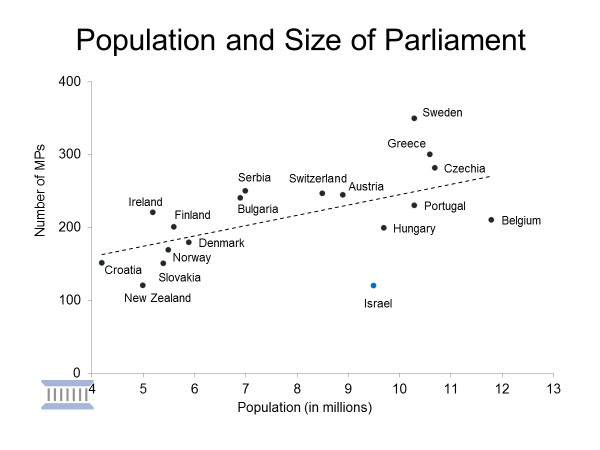
When the State of Israel was established, the number of MKs was larger than might have been expected: The cube root of 600,000 — the estimated number of inhabitants when the state was established — is 84. Currently, with a population of approximately 9.5 million, the number of Knesset members is much smaller than might be expected, since the cube root of 9.5 million is about 210.
Is the number of Knesset members really low? A glance at other countries with populations similar in size to Israel’s, reveals that indeed this is the case. When we compare Israel to 17 democracies with populations ranging from 4-12 million, we see that Israel is the country which deviates most from the average. For example, New Zealand, whose population is half that of Israel’s, has a parliament the same size as the Knesset — 120 members. The parliaments of all the other countries with populations smaller than Israel’s, have a higher number of members than the Knesset does.
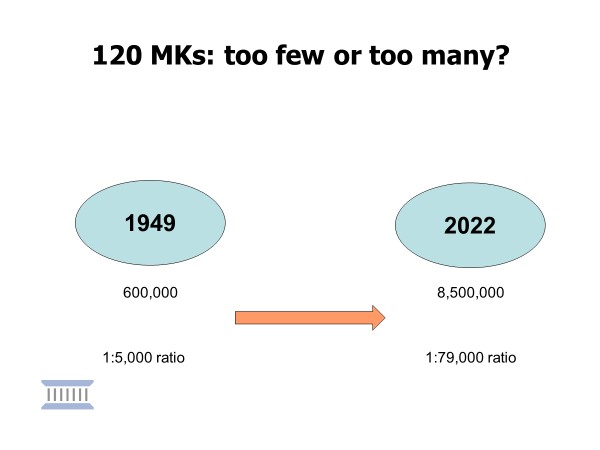
What can we learn from this comparison? Is there any significance in the fact that our representative body is smaller than might be expected?
It can certainly be claimed that the combination of a small Knesset and inflated cabinets (a large number of ministers and deputy ministers, most of whom also serve as Knesset members) has created a situation in which the number of Knesset members who are available for parliamentary work — representing voters, working on high-quality legislation, and supervision of the executive branch — is quite small. From this perspective, the recent implementation of the “Norwegian Law” — allowing ministers and deputy-ministers to resign from their membership in the Knesset and be replaced by “full-time” MKs— is a practical solution. Currently, there are 21 MKs who entered the Knesset as a result of this mechanism.
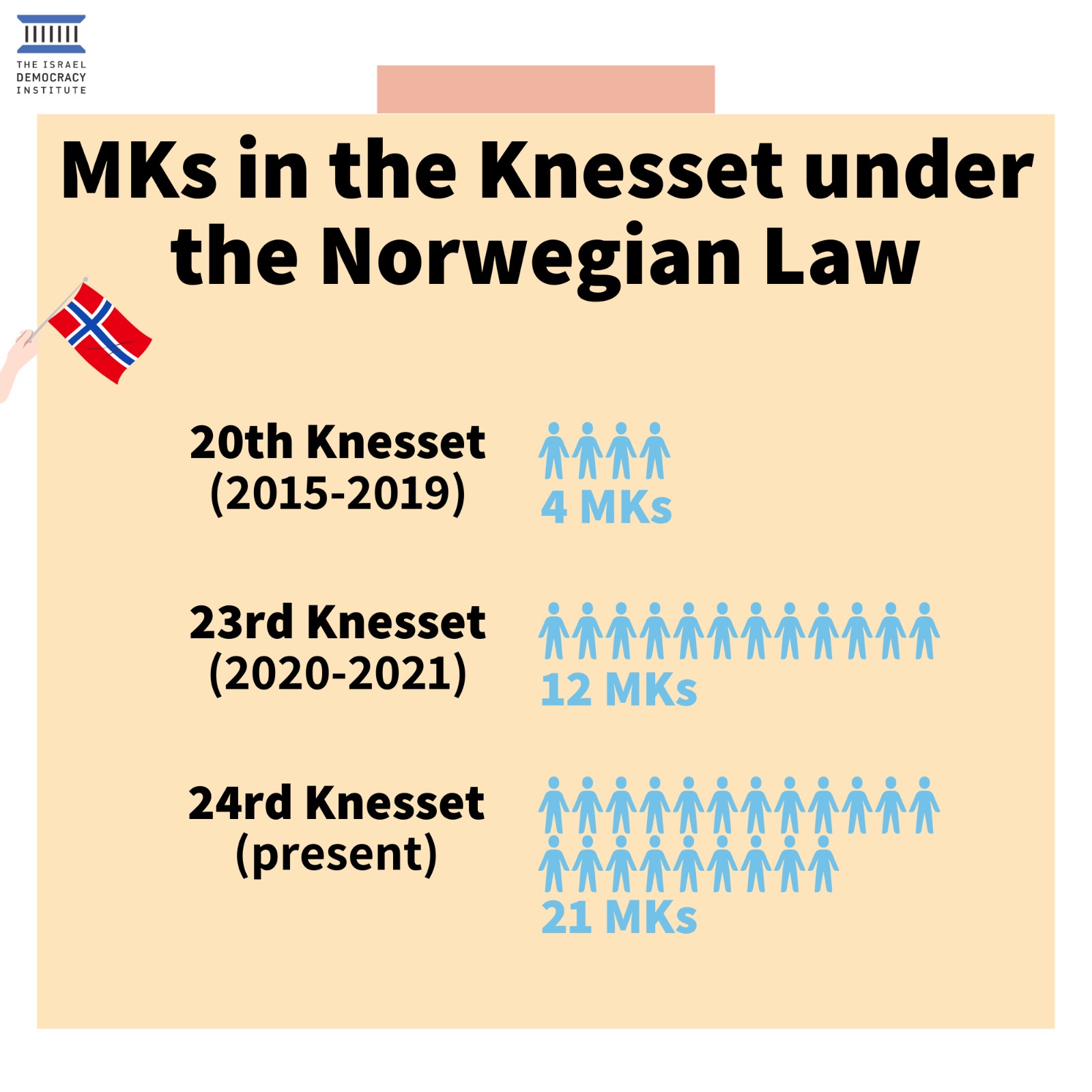
* The Norwegian Law allows a limited number of ministers and deputy ministers to resign from the Knesset. The next candidate in line on the departing minister's slate is then sworn into the Knesset.
